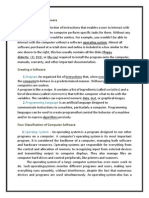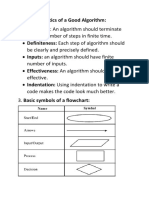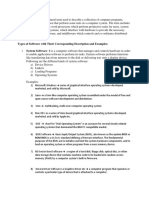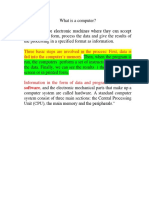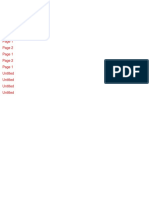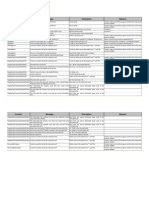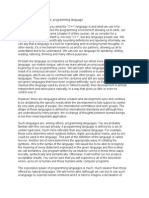0 ratings0% found this document useful (0 votes)
58 viewsComputer Fundamentals
This document provides information about an assignment deadline of May 7th, 2019 and covers various topics in computer science. It discusses the history and features of the C programming language, the benefits of C, a comparison of C and Java, computer ports, executable files, data buses, data servers, artificial intelligence, smartphones, and supercomputers. The document defines each term and provides brief descriptions of the key concepts.
Uploaded by
Top Trending VideosCopyright
© © All Rights Reserved
Available Formats
Download as DOCX, PDF, TXT or read online on Scribd
0 ratings0% found this document useful (0 votes)
58 viewsComputer Fundamentals
This document provides information about an assignment deadline of May 7th, 2019 and covers various topics in computer science. It discusses the history and features of the C programming language, the benefits of C, a comparison of C and Java, computer ports, executable files, data buses, data servers, artificial intelligence, smartphones, and supercomputers. The document defines each term and provides brief descriptions of the key concepts.
Uploaded by
Top Trending VideosCopyright
© © All Rights Reserved
Available Formats
Download as DOCX, PDF, TXT or read online on Scribd
You are on page 1/ 3
Theory Assignment 02
Deadline 07 May,19
(1) Introduction to C-language
C- language is a general-purpose high-level language which was developed by Dennis Ritchie
for Unix operating system. It was used in computer in 1972 for the very first time. C is basically
a procedural programming language to write operating system. The main features of C induce
access to memory, simple set of keywords, and clean style, these features make C language
suitable for system programming like operating system or compiler development. Many later
languages have borrowed syntax directly or indirectly from C language. C++ is nearly a
superset of C language (There are few programs that may compile in C, but not in C++).
(2) Benefits of C-language
As a middle level language, C combines the features of both high level and low-level
languages. It can be used for low-level programming, such as scripting for drivers and it also
supports functions of high-level programming languages, such as scripting for software
applications etc. C is a structured programming language which allows a complex program
to be broken into simpler programs called functions. It also allows free movement of data
across these functions. C language is case-sensitive. C is a general-purpose programming
language and can efficiently work on enterprise applications, games, graphics, and
applications requiring calculations. C language has a rich library which provides a number
of built-in functions.
(3) Comparison of C & Java
C is a Procedural Programming Language. Java is Object-Oriented language.
C is more procedure-oriented. Java is more data-oriented.
C is a middle-level language because Java is a high-level language because
binding of the gaps takes place between translation of code takes place into
machine level language and high-level machine language using compiler or
languages. interpreter.
C generally breaks down to functions. Java breaks down to Objects.
C supports pointers. Java does not support pointers.
It is not portable. It is portable.
(4) Input and Output Ports
A connection point that act as a connection bridge between computer and external devices
like mouse, keyboard, USB etc. is called a port. There are two types of ports
Internal port- It connects mother-board to internal devices like hard-disk drive, CD
drive, etc.
External port- It connects the motherboard to external devices like modem, mouse,
printer, flash drives, etc.
(5) Exe file
Exe is a file extension for an executable file format. An executable is a file that contains a
program - that is, a particular kind of file that is capable of being executed or run as a program
in the computer. An executable file can be run by a program in Microsoft DOS or Windows
through a command or a double click. A file whose name ends in ".exe" is really a program
that when opened causes the operating system to run the program.
(6) Buses (data buses)
A data bus is a system within a computer or device, consisting of a connector or set of wires,
that provides transportation for data. Different kinds of data buses have evolved along with
personal computers and other pieces of hardware. In general, a data bus is broadly defined.
The first standard for the data bus was 32-bit, whereas newer data bus systems can handle
much greater amounts of data. A data bus can transfer data to and from the memory of a
computer, or into or out of the central processing unit (CPU) that acts as the device's "engine."
A data bus can also transfer information between two computers Data buses are fundamental
tools for helping facilitate all of the data transfer that allows so much on-demand data
transmission in consumer and other systems.
(7) Data Server
A data server (DS) is a software program/platform used to provide database services like
storing, processing and securing data. These database services are consumed by other
software programs or components. Sometimes the computer hardware, where the database
is running, is also referred to as a database server. Therefore, the data server can be seen as
the combination of software and hardware platform that runs the installed database and
provides relevant services. Some of the widely used database servers include Oracle, SQL
Server and DB2 etc.
(8) Artificial Intelligence
Artificial intelligence (AI) is the ability of a computer program or a machine to think and learn.
It is also a field of study which tries to make computers "smart". They work on their own
without being encoded with commands. John McCarthy came up with the name "artificial
intelligence" in 1955. In general use, the term "artificial intelligence" means a machine which
mimics human cognition. At least some of the things we associate with other minds, such
as learning and problem solving can be done by computers, though not in the same way as
we do. An ideal (perfect) intelligent machine is a flexible agent which perceives its
environment and takes actions to maximize its chance of success at some goal or objective.
(9) Smart Phone
A smartphone is a cell phone that allows you to do more than make phone calls and send text
messages. Smartphones can browse the Internet and run software programs like a computer.
Smartphones use a touch screen to allow users to interact with them. There are thousands of
smartphones apps including games, personal-use, and business-use programs that can all run
on the phone. A smartphone is expected to have a more powerful CPU, more storage space,
more RAM, greater connectivity options and larger screen than a regular cell phone.
(10) Super Computers
A supercomputer is the fastest computer in the world that can process a significant amount
of data very quickly. The computing Performance of a "supercomputer" is measured very high
as compared to a general-purpose computer. The computing Performance of a
supercomputer is measured in FLOPS (that is floating-point operations per second) instead of
MIPS. The supercomputer consists of tens of thousands of processors which can perform
billions and trillions of calculations per second, or you can say that supercomputers can
deliver up to nearly a hundred quadrillion of FLOPS.
The End
You might also like
- WEEK # 1, 2 & 3 Lecture Material Terminologies: ROM RAM Cache Memory Storage MemoryNo ratings yetWEEK # 1, 2 & 3 Lecture Material Terminologies: ROM RAM Cache Memory Storage Memory14 pages
- Fundamentals of Computer Programming - Unit INo ratings yetFundamentals of Computer Programming - Unit I62 pages
- 7th Term - IT & IS For Construction ManagementNo ratings yet7th Term - IT & IS For Construction Management32 pages
- Mathematics and General Awarness Module4No ratings yetMathematics and General Awarness Module411 pages
- Danica Jane H. Gacita Lou-Gene L. Valencia Lovelle L. HuertaNo ratings yetDanica Jane H. Gacita Lou-Gene L. Valencia Lovelle L. Huerta25 pages
- K.S Polytechnic Department of Mechanical Engineering Bcs LabNo ratings yetK.S Polytechnic Department of Mechanical Engineering Bcs Lab3 pages
- Summary of C: How To Program Sixth Edition by Deitel: Introduction To Computers, The Internet and The WebNo ratings yetSummary of C: How To Program Sixth Edition by Deitel: Introduction To Computers, The Internet and The Web15 pages
- Chapter 1 Introduction: Learning ObjectiveNo ratings yetChapter 1 Introduction: Learning Objective14 pages
- Computer-Basics - CTE I - Computer BasicsNo ratings yetComputer-Basics - CTE I - Computer Basics29 pages
- Software: Computer Software, or Just Software, Is The Collection of ComputerNo ratings yetSoftware: Computer Software, or Just Software, Is The Collection of Computer10 pages
- (Kertas Penerangan) : Information SheetNo ratings yet(Kertas Penerangan) : Information Sheet45 pages
- Chapter 1 The Context of Software DevelopmentNo ratings yetChapter 1 The Context of Software Development14 pages
- Introduction To C Programming-Unit1-Part1No ratings yetIntroduction To C Programming-Unit1-Part151 pages
- How-Computers-Work 20231118 231813 0000No ratings yetHow-Computers-Work 20231118 231813 000028 pages
- Course: Basics of ICT Code: 1431 Assignment # 2 Semester: Spring, 2024 Level: Bachelor/ADNo ratings yetCourse: Basics of ICT Code: 1431 Assignment # 2 Semester: Spring, 2024 Level: Bachelor/AD18 pages
- O o o o O: "C-Sharp" Microsoft Framework. Anders Hejlsberg Founder of C# Language. C++ and Java 2002No ratings yetO o o o O: "C-Sharp" Microsoft Framework. Anders Hejlsberg Founder of C# Language. C++ and Java 20024 pages
- Siva Prasad Muddam Karthik Tadepalli Future Tech Team: Documented byNo ratings yetSiva Prasad Muddam Karthik Tadepalli Future Tech Team: Documented by42 pages
- Differentiate Between Operation System and Application Software Computer ScienceNo ratings yetDifferentiate Between Operation System and Application Software Computer Science6 pages
- Assignment Course Code: MS-07 Course Title: Information Systems For Managers Assignment No.: MS-07/SEM-I/2011 Coverage: All BlocksNo ratings yetAssignment Course Code: MS-07 Course Title: Information Systems For Managers Assignment No.: MS-07/SEM-I/2011 Coverage: All Blocks27 pages
- Computer Awareness Topic Wise - TerminologiesNo ratings yetComputer Awareness Topic Wise - Terminologies15 pages
- External Examiners List For Practical Exam - April 2016-1 PDFNo ratings yetExternal Examiners List For Practical Exam - April 2016-1 PDF25 pages
- Management Information Systems & E-Commerce: Cbu2109 Course OutlineNo ratings yetManagement Information Systems & E-Commerce: Cbu2109 Course Outline4 pages
- Manual de Codigo de Error para SST Ver 1.7No ratings yetManual de Codigo de Error para SST Ver 1.79 pages
- BE Electrical Engineering Scheme of Studies: First Year Spring SemesterNo ratings yetBE Electrical Engineering Scheme of Studies: First Year Spring Semester4 pages
- IIIrd Year I Sem Regular & Supply Results PDF100% (1)IIIrd Year I Sem Regular & Supply Results PDF133 pages
- Practical Source Code For Ship Motions Time Domain Numerical AnalysisNo ratings yetPractical Source Code For Ship Motions Time Domain Numerical Analysis74 pages
- Intrinsic Motivation and The Process of Learning: Beneficial Effects of Contextualization, Personalization, and ChoiceNo ratings yetIntrinsic Motivation and The Process of Learning: Beneficial Effects of Contextualization, Personalization, and Choice16 pages
- List of Computer Awareness AbbreviationsNo ratings yetList of Computer Awareness Abbreviations9 pages
- Managing IT in A Digital World: Objectives100% (1)Managing IT in A Digital World: Objectives11 pages










